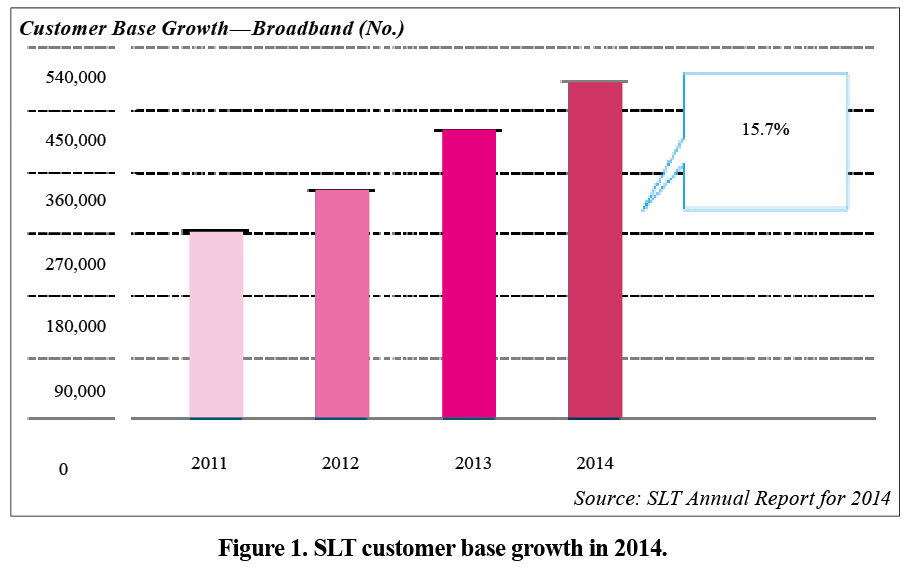SLK BUILDS INFORMATION HIGHWAY
Sri Lanka Telecom (SLT) is the national ICT solutions provider and leading broadband and backbone infrastructure services provider in Sri Lanka. SLT has a user base of more than six million and has a 90% share of the fixed line market in Sri Lanka. By the end of 2014, SLT had attracted nearly 1.15 million fixed line users. SLT began developing CDMA WLL users in 2006, and its WLL user base grew to 550,000 at the end of 2014. SLT has also expanded its broadband market and so far has about 500,000 ADSL broadband users. Since its acquisition of Mobitel (SLT’s wholly owned subsidiary, a mobile service player operating both GSM and WCDMA networks), SLT has become an all-service operator in Sri Lanka that provides fixed, mobile, and data services.
As early as 2011, SLT started a national network modernization project called i-Sri Lanka which was designed to provide high-speed broadband services to the whole country, improve national informatization construction, and contribute to the country’s economic growth.
In July 2011, STL and ZTE signed an exclusive contract for a 600,000-line MSAN Phase-4 project, covering more than 2000 indoor and outdoor sites and over two and a half years of construction. Of all SLT’s landmark projects for fixed broadband construction, this one has the highest contract amount, the largest number of devices and sites, and the largest number of fixed broadband access users. It is also a milestone project for the Sri Lankan government to achieve its national broadband plan.
SLT had to weed out many aging PSTN devices in service for more than 10 years that had high maintenance costs and failed to offer higher bandwidth. Therefore, SLT invited bids for MSAN Phase-5 construction (650,000 lines in total) in June 2013. ZTE secured a 2/3 share of the bid in January 2014.
During the year of project implementation, ZTE impressed SLT for its fast delivery, excellent equipment performance, and rapid response and again won 70% share of the MSAN Phase-5 bid for capacity expansion.
As emerging IP internet services have developed rapidly, cheap IP phones have penetrated traditional TDM. The convenient mobility of 2G and 3G networks and their great varieties of services are also posing huge challenges for traditional fixed line services. It costs much to maintain aging traditional TDM switches and several service access platforms, and new services are difficult to be implemented on the traditional TDM platforms. However, users are increasingly demanding high-speed internet access. All this is giving rise to a revolution in the traditional fixed-line telecom industry and many operators are turning to IP-based integrated bearer access and high-speed broadband services. SLT is no exception. SLT has to have an integrated service access platform that can carry both traditional and high-speed broadband services.
ZTE’s multiservice access node (MSAN) solution oriented to PSTN/NGN/IMS can meet operator demands for integrated broadband and narrowband network construction. The solution incorporates advanced IP, voice, xDSL and xPON technologies and can help SLT build an integrated service access platform that provides a variety of broadband and narrowband access modes, such as ADSL, ADSL2, ADSL2+, VDSL2, SHDSL, POTS, ISDN, DDN, xPON and Ethernet.
ZTE’s MSAN solution provides an integrated fiber and copper access platform that allows smooth evolution to FTTx so that SLT can deploy MSAN in its next-generation optical network. This complies with SLT’s need for smooth network evolution and also protects existing network investment.
Sri Lanka is an island located in the northern Indian Ocean and separated from India by the Palk Strait. The climate of Sri Lanka is typically tropical. Its hot, humid, and rainy environment poses great challenges to the deployment of the MSAN access platform. ZTE has customized moisture and waterproof, heat-resistant outdoor closures to help SLT successfully deploy MSAN outdoors.
ZTE’s MSAN solution not only provides an integrated fiber and copper access platform but also enables effective NE management via a unified NMS. Its line detection system can accurately locate network faults and reduce O&M costs.
ZTE’s MSAN solution uses various green innovations, including smart feeder, higher density ASIC chips, and speed adjustable fans. These innovations make each port consume 30% less power on average than others in the industry. The SLT annual report for 2014 showed that the power consumption of its MSAN project continued to decrease year by year.

The report also showed that SLT’s operating profit for 2014 rose by 8.5% year on year, and its broadband user base grew by 15.7% year on year to reach 500,000 (Fig. 1). ZTE has been highly praised by SLT for its efficient demand response, stable equipment operation, prompt logistical delivery, fast networking capability, and satisfactory after-sales service. During the MSAN project, ZTE has become SLT’s most valuable and trusted partner for integrated service access solutions.